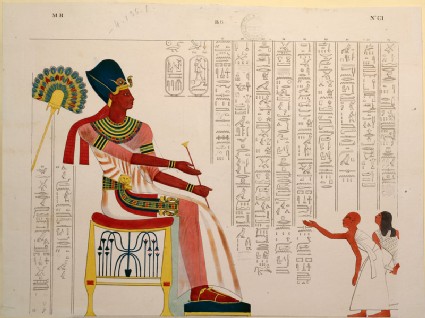Browse: 1470 objects
Engraving of a Relief of Ramesses II receiving Suppliants from the Depiction of the Battle of Qadesh in the Great Hall of the Temple at Abu Simbel Anonymous Italian
-
Curator’s description:
Description
The engraving is arranged in two registers. On the top, a pharaoh sits on a throne, a fan behind his head, as two smaller figures approach, bowing, from the right. The spaces behind the pharaoh and between him and his suppliants are filled with hieroglyphic inscriptions. On the bottom is a line of the pharaoh's bodyguard, of two types: on the left, armed with swords, round shields and helmets with circular crests, wearing their hair short but with long sideburns; on the right, armed with spears, hatchets, and long shields, wearing their hair long (the foreign Shardana). The pharaoh is Ramesses II (c.1187-c.1156 BC), and the relief is part of the vast depiction of the Battle of Qadesh which occupies an entire wall in the Great Hall of the Temple at Abu Simbel (Porter & Moss, "Topographical Bibliography", 2nd ed, Oxford (Clarendon Press & Griffith Institute): 1960-1999, vol. VII, pp. 103-104).
The print is taken from the first volume of plates from Ippolito Rosellini's "Monumenti dell' Egitto e della Nubia", published in 1832. It was first catalogued by Ruskin in the "Catalogue of Examples" of 1870, as no. 101 in the Standard Series; in the 1872 catalogue of the Standard and Reference Series, it was renumbered as no. 176 in the Reference Series. It was placed alongside other plates from Rosellini, including one depicting the entire image, of which this is but a detail, at no. 178. Cook and Wedderburn's identification of this item in the catalogues as Rosellini's vol. III, Tavole, pl. LXXXVI (XXI.44 n. 3) is clearly erroneous, and Ruskin himself makes it clear that this is one of the details which immediately followed Reference Series no. 178 in Rosellini's book.
Neither the draughtsman, named as 'C', nor the engraver, named as 'M', can be identified with certainty.
In a note in "The Ethics of the Dust", explaining how the individual aspects of the Egyptian deities were still largely unknown, Ruskin was somewhat sceptical of Rosellini's qualities: 'for the full titles and utterances of the gods, Rosellini is as yet the only - and I believe, still a very questionable - authority' (Ethics of the Dust, note III = XVIII.363). In his entry below nos 176-180 in the Reference Series, Ruskin again questioned Rosellini's accuracy, noting that the colours were sometimes conjectural, 'slight traces of the original pigments, and those changed by time, being interpreted often too arbitrarily' (Standard and Reference Series catalogue, p. 22).
In the section of "Aratra Pentelici" which expanded upon his lecture on "Imagination" of 26 November 1870, Ruskin was more interested in the relationship between sculpture and polychromy, noting that 'all the early sculpture of the most accomplished nations has been thus coloured' and that, as soon as colour was applied within a scratched outline, 'the colouring soon becomes a principal means of effect, so that, in the engraving of an Egyptian-colour bas-relief (S. 101 [this object]), Rosellini has been content to miss the outlining incisions altogether, and represent it as a painting only' (Aratra Pentelici, § 32 = XX.222)
-
Details
- Artist/maker
-
Anonymous Italian (Anonymous, Italian) (artist, engraver)
- Object type
- Material and technique
- watercolour and bodycolour over engraving on wove paper
- Dimensions
- 326 x 434 mm (stone); 370 x 497 mm (sheet)
- Associated place
-
- The Ancient Egyptian World › Nubia › Abu Simbel › The Great Temple › The Great Temple (subject)
- Inscription
- Recto, all engraved:
top left: M.R.
top centre: B.6.
top right: No. CI
the columns of hieroglyphs in the background are labelled with a number above each column, reading, right to left, '19' to '27'
bottom left (trimmed off this impression): C.
bottom right (trimmed off this impression): M. Scul.
Recto, on the top edge, above the head of the seated figure, in graphite: 4.135.1
Verso:
top, towards right, in graphite: 4.135.1
just to the right, in graphite: Very fine for apposed [?] noble and | ignoble expression Compose [?] | plate 155 here
top, just left of centre, the Ruskin School's stamp
On a separate paper label:
top left corner, in ink: 101
across the sheet, just above centre, in graphite: Sland [sic = Stand] arc [?] - 102 - Ramises 3 and Suppliants [the label is torn between '102 -' and 'Ramises', and the inscription is in different hands either side of the tear]
- Provenance
-
Presented by John Ruskin to the Ruskin Drawing School (University of Oxford), 1875; transferred from the Ruskin Drawing School to the Ashmolean Museum, c.1949.
- No. of items
- 1
- Accession no.
- WA.RS.REF.176
-
Subject terms allocated by curators:
Subjects
-
References in which this object is cited include:
References
Ruskin, John, Catalogue of Examples Arranged for Elementary Study in the University Galleries (Oxford: Clarendon Press, 1870), cat. Standard no. 101
Rosellini, Ippolito, I monumenti dell' Egitto e della Nubia: Disegnati dalla spedizione scientifico-letteraria toscana in Egitto: distributi in ordine di materie, 12 (Pisa: Presso N. Capurro, 1832-1844), pt III, Tavole, pl. CI
Ruskin, John, Catalogue of the Reference Series Including Temporarily the First Section of the Standard Series (London: Smith, Elder, [1872]), cat. Reference no. 176
Ruskin, John, ‘Aratra Pentelici: Six Lectures on the Elements of Sculpture, Given Before the University of Oxford in Michaelmas Term, 1870’, Edward T. Cook and Alexander Widderburn, eds, The Works of John Ruskin: Library Edition, 39 (London: George Allen, 1903-1912), 20
Ruskin, John, ‘The Ruskin Art Collection at Oxford: Catalogues, Notes and Instructions’, Edward T. Cook and Alexander Wedderburn, eds, The Works of John Ruskin: Library Edition, 39 (London: George Allen, 1903-1912), 21, cat. Reference no. 176
Location
-
- Western Art Print Room





